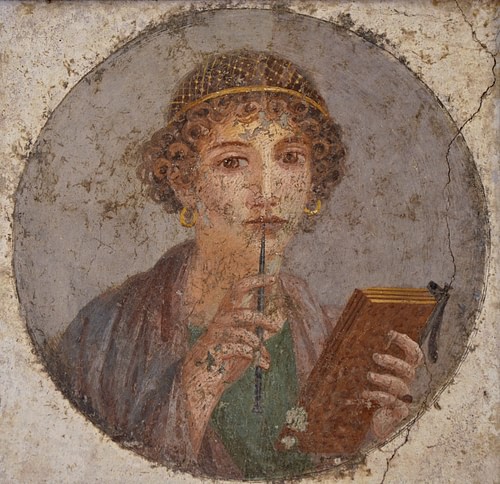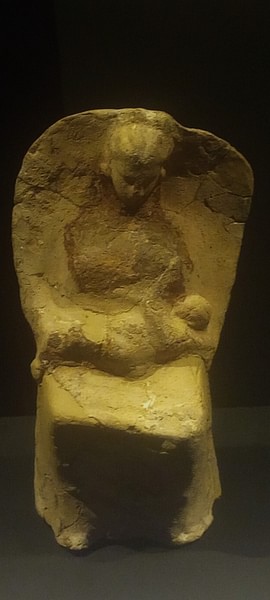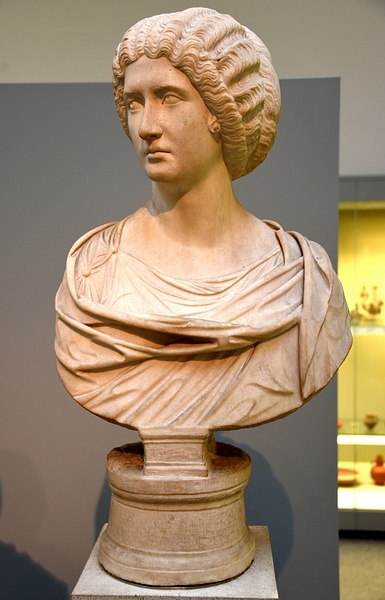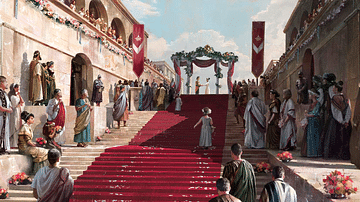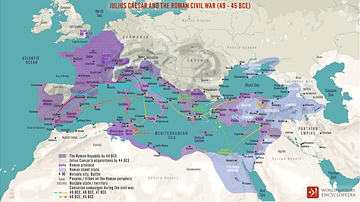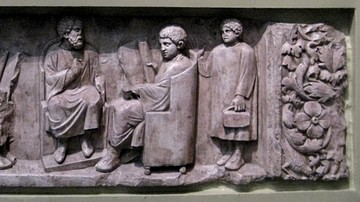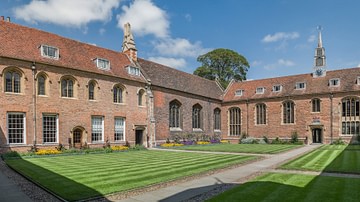The upbringing and education of girls in ancient Rome are rarely addressed in ancient sources. A young Roman girl from an affluent family married very young, often in her mid-teens, and girls, according to tradition, were brought up solely for marriage and to bear children. A Roman girl's formal education, mainly dictated by the prospect of early betrothal, was short-lived.
Although education was seen as crucial to self-advancement, the Roman education system was directed towards a young boy's 'career' in politics or in the Roman law courts. It prepared the boy for his entrance into public life and was key to him obtaining a prominent position in Roman government and society.
The Roman Education System
Formal education for children began at about the age of seven years; girls from affluent and elite levels of society would have received an elementary education at home from a private tutor, as would the boys. However, if a father did not employ private tutors, children may have been enrolled in schools outside of the home. This early education for both sexes would have included reading, writing, maths, and Greek and Latin literature. Plutarch (c.45-50 to c.120-125 CE) writes of nine-year-old Pompeia, daughter of Pompey, proudly reciting verses to her father from Homer's Illiad (Quaest. Conv. 9.1.3).
On completion of this elementary level, boys aged around 12, progressed onto classes at the school of the grammaticus, where they would develop and refine their writing and speaking skills as well as study philosophy, astronomy, and natural science; it is here that boys also began their preparation for oratorical studies. Girls did not attend the schools of the grammaticus. At the age of 15 or so, having possibly assumed the adult toga as part of a Roman boy's rite of passage, boys then moved on to the rhetor where they would learn to become skilful orators, study law, politics, astronomy, geography, Roman and Greek literature, philosophy and mythology. The wealthy young males might then further their education by joining fellow Roman students in Athens and other intellectual centres in the Far East. Roman girls by the age of 15, could already be married, could already be mothers, and if not, they were being prepared to be such.
The Traditional Path & Controversial Education
A girl's identity was very much associated with her family or her husband; she was someone's daughter, wife, or mother, and recognition of who she was would be established by how well she performed these roles, not by any scholarly achievements. When it came to education, there was a view that educating young girls would disrupt or 'spoil' their personal preparation for marriage and motherhood. Educating girls was believed to be more about instilling virtue, the best preparation for their lives as wives. Roman funeral epitaphs for females provide an understanding of the ideals of men when it comes to young girls and women, with many eulogies including the words "modest," "chaste" and "stay at home" – expressions which would have reflected ancient Roman family life.
The role of women in the Roman world, after all, was primarily to bear children and manage a household; a liberal education it was believed had the potential to distract them from those traditional ideals of modesty, chastity, and domesticity, turning them into unfaithful or unbearable wives. However, it would be far from correct to dismiss education as unattainable. The early age of marriage may have caused education to be less extensive and more haphazard, but access to a wider education was not necessarily out of reach for girls. Furthering a girl's education greatly depended on her circumstances, such as wealth and the standing of the family in ancient Roman society, and of course, the inclination of the family to spend money on the education of a daughter. Should parents choose to, it would have been possible for a young girl to continue her early studies with a grammaticus as part of her private instruction.
There is limited evidence of education for girls from the end of their elementary education up to the time of their betrothal. We do know that any education would have been a literary one, rhetoric was not for girls, as it was very much in the male domain. Literary education included writing prose and reading, especially Greek and Roman poetry; the poet Martial (c. 38-41 to c. 103 CE) considered epic and tragic poetry for the "grown girl" as the most suitable for cultivating a sense of proper conduct (Ep. 8.3.13-16). In some circles, literary instruction at home possibly lasted the longer the girl remained unmarried. Nevertheless, even with the most favourable of situations, early marriage did mean that young girls found themselves undereducated in comparison to the male members of their families, who would have continued their studies for several years more.
Educate Girls?
The Stoic philosopher Gaius Musonius Rufus (30-100 CE), argued for the appropriateness of a good education, including philosophy for young girls. Musonius argued that somehow we think that males should have a superior education, but he believed that sons and daughters should be equally educated. Musonius' belief was that philosophy must be studied not just to cultivate brilliance in arguments or great cleverness but also to develop good character and a sound mind. His argument was that males and females have the same virtues and thus must receive the same education in philosophy. We might certainly consider that Musonius' teachings deserve to be taken seriously as a reflection of at least a part of contemporary liberal educated opinion in Rome; modern scholarship suggests that the titles of some of Musonius' lectures such as 'Daughters should have the same education as sons' or 'Women should study philosophy' point to the fact that these issues were being debated in Rome at the time. However, Musonius is reluctant to challenge the traditional sphere of the female; a young girl's role remained traditionally mapped out to support a husband and family, and Musonius believed that, through a modicum of philosophical education, a daughter could be molded into the ideal marriage candidate.
Young girls and wives could, in the right circumstances, seek an education for themselves. We do have mention in the primary sources of some well-educated upper-class girls, which indicates that a good education was given to some daughters. Pliny the Younger (61-127 CE) writes of thirteen-year-old Minicia Marcella who died just before her marriage; Pliny says that she had received a full education in literature and the liberal arts (Ep. 5.16). He speaks highly of her intellect and her determination; strikingly, he does not make her education at this level appear exceptional.
The benefits of further education for a young girl or woman of elite society may, in some quarters, have been considered an asset. In some cases, her social role may have necessitated her being capable of engaging in cultivated conversation, may have required her to socialise with a level of intellectual confidence within a certain company, and most importantly, it would have enabled her to support her husband. Married girls could have sought out private tutors to further their education; some may have furthered their education by instruction from their husband, who was usually older. Pliny, writing of his own very young third wife, refers to her being extremely clever and having an interest in literature, which he says she has developed through her devotion to him (Epist. 4.19).
Self-educating was also a possibility for girls; reading literature, attending theatre and cultural events in order to help broaden their intellectual horizons, and learning from the older women of their circle. Quintilian, rhetor and educator, stresses in his Institutio oratoria the importance of the parents of his young ideal (male) orator being as highly educated as possible, and he goes as far as to say, that he does not restrict this comment to fathers alone (1.1.6).
The aim of any education for girls was seen as a way of enabling them to amplify the virtues for which they would be valued as prospective wives. It would be true to say that in some circles women's lives may have been very much a balancing act between being charming and modest; assisting their husband's career by behaving with grace and dignity, and. for those educated women, taking care not to appear more intelligent than their husbands or those other men around them.
Seneca the Younger (c. 4 BCE to 65 CE), writing in De Consolatione Ad Marciam, tells of his father's objection to Seneca's mother dedicating herself to philosophical instruction, his concern being that she would misuse it for vanity rather than academic advancement (17.4). Anxiety about females using intellect for show rather than for substance was a common concern, however, Seneca rejects his father's traditional view and encourages his mother to return to her studies. The satirist Juvenal (c. 55-60 to c. 127 CE) writing in his Satires 6, indicates a part of society in which there are confident, intellectual women, although not particularly to his liking, he complains of the annoying, educated, loud woman at dinner who overwhelms guests with her knowledge.
Conclusion
Despite the concerns, a good education was nevertheless a sign of wealth and high social status. It is clear that early marriage and motherhood brought the elementary education of girls to an end, but whether it was the parents' wish or the girl's or her husband's desire, further education remained achievable. Girls in some elite families may have advanced their education if they were expected to be informed companions of their older husbands. Fathers from competitive elite families or the ruling classes sought out marriage alliances for their daughters, to promote their own personal or political interests; enhancing their daughters' intellectual knowledge with the prospect of particular alliances would have been beneficial. The Roman general and statesman, Pompey (106-48 BCE) had a younger wife, who Plutarch records as being well-versed in literature, playing the lyre, in geometry, and she had been accustomed to philosophical discourses (Pomp. 55.1). In the imperial household, independent-minded Julia (39 BCE-14/15 CE), the infamous daughter of the Roman emperor Augustus (r. 27 BCE to 14 CE), and Agrippina the Elder (c. 14 BCE to 33 CE), granddaughter of Augustus, were recognised for their skills in writing and composition.

